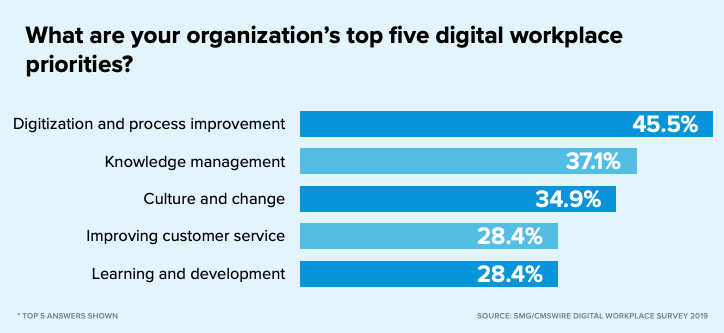Leaders Can Build a Modern Workplace Faster by Storytelling
Most digital workplace leaders talk about their plans to build a modern workplace. Some are even making progress. CIOs are implementing new technologies. COO’s are changing the workplace environment. CHROs are evolving remote work policies.
All these activities are consistent with findings from the recently released The State of the Digital Workplace Report. The report included survey results from over 450 leaders. In response to questions about digital workplace initiatives being a top or important priority. This year’s findings show 76.9% agreed.
While there is some good news here, there is still a problem—the “need for speed.” Findings showed that 42% of companies are in an early phase of maturity.
“10 Key Takeaways” in the report make it clear that most companies are experiencing leadership issues (see examples below):
#2- “A mature, effective digital workplace is an important destination, but this is a work in progress. Nearly half of organizations consider the digital workplace extremely or very important, but the majority are at an early stage of maturity.”

#4-Half-hearted support from top leadership is stifling digital workplace progress. Top digital workplace challenges, including budget constraints and a lack of strategic direction, reflect a lack of concrete C-level support.”
#10 “Ownership of the employee experience is still up for grabs. The lack of consensus on who owns the employee experience could make it hard.”

Digital Workplace Ownership Challenges and Company Culture
For a company culture to embrace the importance of the digital workplace experience, a team of leaders are required—specifically the C-Suite.
As simple as it sounds to secure members of a committed C-Suite team, leaders overlook taking this action. The research proves this approach won’t work.
However, the sooner you engage with stakeholders across the board, the faster your efforts move.
First, you and other C-Suite leaders need to shift the company culture. Your company culture needs to agree on a strategy that moves employees towards embracing the digital workplace.
Then, form an internal team that includes the CEO, CIO, CHRO and Corporate Communication. An internal team of communicators can make or break digital workplace efforts.
Michael Wetzel, a Senior Manager at a large CPG company in Central Pennsylvania, who led a workplace solutions program, said:
“When it comes to digital transformation and the modern workplace, it’s your company culture that’s going to determine how you end up. You can buy the latest, greatest tools and make this seamless ecosystem, but if your culture is where people hoard information or don’t collaborate well, it’s not going to be successful.”
Once your team is formed and committed to a digital workplace experience, share your journey with the Digital Workplace Experience community.
Caution: Don’t wait to share until everything you do works perfectly!
Your company’s team and the community as a whole can evolve faster by sharing stories about successes, challenges and lessons learned.
Leaders sharing stories helps your colleagues in the DWX community identify strategies to build their version of ownership and cohesive leadership.
Next, engage with employees. This can start by asking employees questions about what they want and need in the digital workplace. Below are three examples of questions to ask:
- What do you need to do your best work?
- What do you want your work environment to look/feel like?
- What tools will make it easier for you to work more efficiently and effectively?
Tip: The sooner you engage employees the sooner they adapt to change.
According to PwC, change moves more quickly when the C-Suite engages informal influential leaders responsible for workforce-led value creation. In other words, “socially connected influencers.”
Socially connected influencers at all levels help the leadership team figure out how to shift behavior at the employee level.
Next Steps for Leaders to Take—Continue Conversations About your Journey
Now is the time to continue conversations that began in June of 2019 at the DWX conference. Connections made at the June DWX conference left people feeling they are part of an energized group of like-minded people.
Leaders who want to see digital collaboration in the workplace as the norm vs. the exception, can solve the “need for speed” problem by working with colleagues in the DWX community.
What if we challenged ourselves to continue conversations between now and the June 2020 conference? The challenge would be for leadership teams to share progress as it is achieved throughout the year.
Here are a few questions to prompt our conversation:
- How are you securing top leadership buy-in?
- What changes in your company culture will help transform the employee experience?
- Which of your organization’s top 3 digital workplace challenges are first on the list?
If we start the conversation now, imagine the stories we would be able to tell by next June!
What stories and questions would you like to share?



